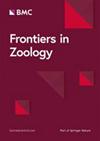Sex differences in foraging ecology of a zooplanktivorous little auk Alle alle during the pre-laying period: insights from remote sensing and animal-tracking
IF 2.6
2区 生物学
Q1 ZOOLOGY
引用次数: 0
Abstract
Energy and time allocation in seabirds differ between consecutive stages of breeding given various requirements of particular phases of the reproductive period. Theses allocations may also be sex-specific considering differential energetic or nutritional requirements of males and females and/or sexual segregation in foraging niches and/or areas. In this study we investigated the foraging ecology of an Arctic, zooplanktivorous seabird, the little auk Alle alle during the pre-laying period using remote sensing of the environment and GPS-TDR loggers deployed on birds. We compared foraging trips range and habitats of birds with other stages of the breeding period and between sexes. We found that little auks during the pre-laying period foraged exclusively in cold sea surface temperature zones (with temperatures < 5 ºC) but in various sea depth zones. They dived to similar depths ranging from -4.0 to -10.9 m, exploring various thermal microhabitats (with mean temperatures values ranging from 2.2 °C in Shelf sea depth zone to 5.9 °C in Deep sea depth zone). The majority of foraging trips and dives characteristics were similar to subsequent phases of breeding. However, home ranges during the pre-laying trips were wider compared to the incubation period. As expected, females exhibited wider foraging niches compared to males (wider range of sea surface temperature and sea depth in foraging locations), which could be explained by sex specific energetic and/or nutritional requirements (females producing an egg). We also delineated local foraging areas important for little auks during their whole breeding season. Protection of these areas is crucial for sustaining the local marine biodiversity. We found that little auks females during the pre-laying period explored wider foraging niches compared to males. These differences may be attributed to sex-specific nutritional or/and energetical constraints at this stage of breeding. The results of this study also emphasize the importance of shelf Arctic-type water masses as the foraging areas for little auks during successive stages of breeding.产卵前期浮游动物Alle alle觅食生态的性别差异:遥感和动物追踪的启示
由于繁殖期特定阶段的不同要求,海鸟在不同连续繁殖阶段的能量和时间分配也不同。考虑到雌性和雄性对能量或营养的不同需求和/或在觅食壁龛和/或区域的性别隔离,这些分配也可能具有性别特异性。在这项研究中,我们利用环境遥感和部署在鸟类身上的 GPS-TDR 记录仪,调查了北极地区的一种浮游动物海鸟--小赤麻鸭在产卵前期的觅食生态。我们比较了繁殖期其他阶段和不同性别鸟类的觅食行程范围和栖息地。我们发现,小白鹭在产卵前期只在寒冷的海面温度区(温度小于 5 ºC)觅食,但在不同的海深区觅食。它们潜入的深度从-4.0米到-10.9米不等,探索不同的热微生境(平均温度值从浅海深度区的2.2 °C到深海深度区的5.9 °C不等)。大多数觅食行程和潜水特征与随后的繁殖阶段相似。然而,与孵化期相比,产卵前期的觅食范围更广。正如所料,雌性的觅食范围比雄性更广(觅食地点的海面温度和海深范围更广),这可能与性别特有的能量和/或营养需求(雌性产卵)有关。我们还划定了小海鸥在整个繁殖季节的重要觅食区域。保护这些区域对维持当地海洋生物多样性至关重要。我们发现,在产卵前期,雌性小海鸥比雄性小海鸥的觅食范围更广。这些差异可能是由于在这一繁殖阶段,不同性别的营养或/和能量限制造成的。该研究结果还强调了北极陆架型水团作为小海鸥连续繁殖阶段觅食区的重要性。
本文章由计算机程序翻译,如有差异,请以英文原文为准。
求助全文
约1分钟内获得全文
求助全文
来源期刊

Frontiers in Zoology
ZOOLOGY-
CiteScore
4.90
自引率
0.00%
发文量
29
审稿时长
>12 weeks
期刊介绍:
Frontiers in Zoology is an open access, peer-reviewed online journal publishing high quality research articles and reviews on all aspects of animal life.
As a biological discipline, zoology has one of the longest histories. Today it occasionally appears as though, due to the rapid expansion of life sciences, zoology has been replaced by more or less independent sub-disciplines amongst which exchange is often sparse. However, the recent advance of molecular methodology into "classical" fields of biology, and the development of theories that can explain phenomena on different levels of organisation, has led to a re-integration of zoological disciplines promoting a broader than usual approach to zoological questions. Zoology has re-emerged as an integrative discipline encompassing the most diverse aspects of animal life, from the level of the gene to the level of the ecosystem.
Frontiers in Zoology is the first open access journal focusing on zoology as a whole. It aims to represent and re-unite the various disciplines that look at animal life from different perspectives and at providing the basis for a comprehensive understanding of zoological phenomena on all levels of analysis. Frontiers in Zoology provides a unique opportunity to publish high quality research and reviews on zoological issues that will be internationally accessible to any reader at no cost.
The journal was initiated and is supported by the Deutsche Zoologische Gesellschaft, one of the largest national zoological societies with more than a century-long tradition in promoting high-level zoological research.
 求助内容:
求助内容: 应助结果提醒方式:
应助结果提醒方式:


